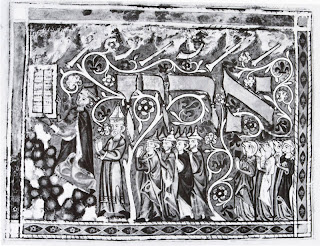As has often been noted, medieval Christian art had a tendency to draw biblical figures in contemporary dress. Underlying this perspective was a view of history that did not distinguish between past and present. To the medieval mind there was no real difference between King David and the king of France nor, for that matter, were the apostles really different from priests. If Peter was the first pope then it made perfect sense to paint him as one. One of the important revolutions within the Renaissance in the fifteenth century was precisely the gaining of such a historical perspective. It began in linguistics, when Italian humanists came to the realization that medieval church Latin, let alone Tuscan, was truly different from, and from their perspective inferior to, the Latin of Cicero. The practical implications of this new historical perspective began to be seen in biblical studies with Erasmus' attack on the Vulgate text. Underlying this was a realization that the Bible of the medieval Church was not the Bible of the early Church and not just in terms of Latin and Greek. This proved foundational to the Protestant Reformation; underlying Luther's attack on the Catholic Church was the argument that the Church itself was not the same Church as the one created by the apostles and held out to his followers the possibility of recreating that apostolic Church. For all the focus on the revolution of Renaissance art with its discovery of perspective, in terms of history the arts were behind the curve, continuing to draw biblical figures in contemporary dress for centuries.
What is interesting is that Jewish art from this period shows the exact same tendencies. This should not be so surprising as medieval Jews, by and large, possessed similar values as their Christian neighbors. Furthermore the artists themselves were not necessarily Jewish. One could work on an illuminated Bible one day and a Hebrew prayer book the next.
Here are some examples from the fourteenth century I found from the introductory volume to The Bird's Head Haggada of the Bezalel National Art Museum of Jerusalem.
The giving of the Ten Commandments at Mount Sinai from the Tripartite Mahzor. The Israelites look like medieval Jews with the traditional pointed Jewish hats. (No medieval Ashkenazi Jews did not wear shtreimels or black fedoras. Try your luck with the Sefardim.) Why the women look like demons is a mystery to me. But notice Moses dressed like a king and Aaron, the high priest, looking like, of all things, a bishop. This is particularly ironic as medieval Christians tended to draw positive biblical characters like Abel in Christian clothing while making villains like Cain look like Jews.
Here the Leipzig Mahzor gives us Pharaoh's army as a band of armored knights. One wonders about the crescent banner; are the Egyptians supposed to be Muslims?
The Duke of Sussex Pentateuch shows the four sides of the Israelite camp. What should the armies of Israel be dressed in to prepare to invade the Land of Canaan, but crusader armor. (See Jews and Art: Secret Transcripts.)




1 comment:
The reason why the women look like "demons" is that Jews were debating the drawing of human figures in religious texts during the middle ages.
Christianity was embroiled in the same debate early on--is it or is it not idolotrous?--with the Catholic Church eventually deciding that it was okay to have images of humans in religious art (iconography).
Jews greatly disapproved of this practice, which they felt was idolotrous. Even today, you are not likely to see a picture of a human figure in a synagogue sanctuary--not even in a Reform shul.
However, there was debate among the various Jewish communities/rabbis during the middle ages as to whether you could have human figures in a Haggadah, since it was a book. As you point out in your post, Christians were using pictures to illustrate scenes from the Bible (and everyday life), and I daresay people saw value in that, just as we use illustrated Haggadahs today to help small children understand the seder and the Bible story.
So you end up with three different schools of thought, all pretty much existing side-by-side: in the so-called "Birds-Head Haggadah," all of the humans have bird-like heads. This allows you to identify the figures as human, but technically keeps the illustration within the strict interpretation of the law of not depicting people. (I think Jews invented the word "loophole.")
The second style--as in the Tripartite Mahzor--was to give the women animal-like faces, since it could be considered immodest to look at women. (The Hasidic community still strictly observes this--to the point that one Hasidic newspaper Photoshopped Hillary Clinton out of the picture of the war-room during the bin Laden raid.)
The third option was to just depict humans as human.
Post a Comment